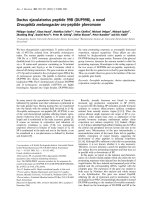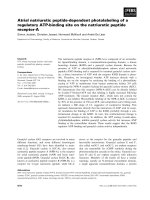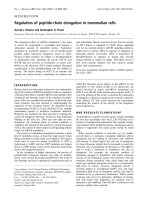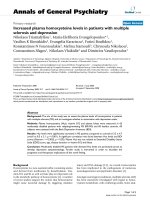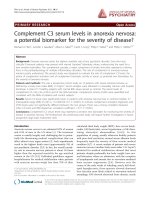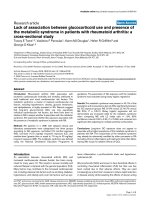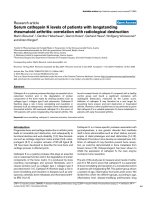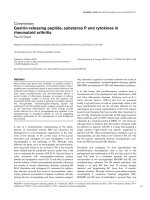Báo cáo y học: "Brain natriuretic peptide levels have diagnostic and prognostic capability for cardio-renal syndrome type 4 in intensive care unit patients" pps
Bạn đang xem bản rút gọn của tài liệu. Xem và tải ngay bản đầy đủ của tài liệu tại đây (366.84 KB, 11 trang )
Open Access
Available online />Page 1 of 11
(page number not for citation purposes)
Vol 13 No 3
Research
Brain natriuretic peptide levels have diagnostic and prognostic
capability for cardio-renal syndrome type 4 in intensive care unit
patients
Sunghoon Park
1
, Goo-Yeong Cho
2
, Sung Gyun Kim
3
, Yong Il Hwang
1
, Hye-Ryun Kang
1
,
Seung Hun Jang
1
, Dong-Gyu Kim
1
, Young Rim Song
3
, Young-A Bae
4
and Ki-Suck Jung
1
1
Division of Pulmonary, Allergy and Critical Care Medicine, Department of Internal Medicine, Hallym University Sacred Heart Hospital, 896 Anyang,
Kyunggi-do, 431-070, Republic of Korea
2
Division of Cardiology, Department of Internal Medicine, Hallym University Sacred Heart Hospital, 896 Anyang, Kyunggi-do, 431-070, Republic of
Korea
3
Division of Nephrology, Department of Internal Medicine, Hallym University Sacred Heart Hospital, 896 Anyang, Kyunggi-do, 431-070, Republic of
Korea
4
Department of Radiology, Hallym University Sacred Heart Hospital, 896 Anyang, Kyunggi-do, 431-070, Republic of Korea
Corresponding author: Ki-Suck Jung,
Received: 11 Feb 2009 Revisions requested: 17 Mar 2009 Revisions received: 29 Apr 2009 Accepted: 15 May 2009 Published: 15 May 2009
Critical Care 2009, 13:R70 (doi:10.1186/cc7878)
This article is online at: />© 2009 Park et al.; licensee BioMed Central Ltd.
This is an open access article distributed under the terms of the Creative Commons Attribution License ( />),
which permits unrestricted use, distribution, and reproduction in any medium, provided the original work is properly cited.
Abstract
Introduction Limited data are available regarding the diagnostic
and prognostic utility of brain natriuretic peptide (BNP) in
patients with chronic kidney disease (CKD) in the intensive care
unit (ICU) setting.
Methods All patients with CKD and a serum creatinine (Cr) of
2.0 mg/dl or higher admitted to the ICU between January 2006
and September 2007 were enrolled in this study. The CKD
group was divided according to the presence or absence of
acute decompensated heart failure (ADHF) into CKD + ADHF
and CKD - ADHF groups, respectively. Other patients with
ADHF having low Cr (<1.2 mg/dl) in the coronary care unit were
also recruited as a control group during the same period. BNP
levels at the time of admission (admission BNP) were compared
amongst these groups. We then sought to determine whether
BNP levels could predict the outcome in patients with CKD.
Results Of 136 patients with CKD for whom data were
available, including 58 on dialysis (42.6%), 81 (59.6%) had
ADHF and their estimated glomerular filtration rate (eGFR) was
12.8 ± 7.3 ml/min/1.73 m
2
. BNP levels at admission were
2708.6 ± 1246.9, 567.9 ± 491.7 and 1418.9 ± 1126.5 pg/ml
in the CKD + ADHF, CKD - ADHF and control groups (n = 33),
respectively (P = 0.000). The optimal cutoff level in patients with
CKD was 1020.5 pg/ml (area under the curve = 0.944) to
detect ADHF from the receiver operating characteristic (ROC)
curve. This level was not associated with in-hospital mortality,
all-cause death or a composite event (all-cause death and/or
new cardiac event). However, a borderline significant
association was observed with new cardiac events (hazard ratio
(HR) = 4.551; P = 0.078) during the follow-up period (521.1 ±
44.7 days). Furthermore, continuous variables of BNP and BNP
quartiles were significantly associated with new cardiac events
in the multivariate Cox model (HR = 1.001, P = 0.041; HR =
2.212, P = 0.018).
Conclusions The findings suggest that the level of BNP at the
time of admission may be a useful marker for detecting ADHF
and predicting cardiac events in patients with CKD in the ICU
setting.
ACS: acute coronary syndrome; ADHF: acute decompensated heart failure; ALI: acute lung injury; ARDS: acute respiratory distress syndrome; BNP:
brain natriuretic peptide; BUN: blood urea nitrogen; CHF: congestive heart failure; CI: confidence interval; CKD: chronic kidney disease; Cr: creati-
nine; CRP: C-reactive protein; CRS: cardio-renal syndrome; EF: ejection fraction; eGFR: estimated glomerulofiltration rate; ICU: intensive care unit;
IQR: interquartile range; LAD: left atrial dimension; LV: left ventricle; LVMI: left ventricular mass index; MV: mechanical ventilation; OR: odds ratio;
ROC: receiver operating characteristic; SAPS II: simplified acute physiology score II; SOFA: sequential organ failure assessment.
Critical Care Vol 13 No 3 Park et al.
Page 2 of 11
(page number not for citation purposes)
Introduction
Cardiovascular disease is a leading cause of death in patients
with chronic kidney disease (CKD), for whom the cardiovascu-
lar mortality rate is 15 to 30 times higher than in the general
population [1,2]. Acute decompensated heart failure (ADHF)
occurs in approximately 40% of patients with CKD and is a
strong independent risk factor for mortality [2,3]. Recently, the
importance of heart-kidney interaction has received wide-
spread attention, and a new classification of the cardio-renal
syndrome (CRS) with five subtypes has been proposed. In this
classification, CRS type 4 is characterised by a condition of
primary CKD contributing to decreased cardiac function, ven-
tricular hypertrophy and/or increased risk of adverse cardiac
events [4,5].
Brain natriuretic peptide (BNP), a bioactive cardiac neurohor-
mone secreted from the ventricular myocardium in response to
myocardial stretching and volume overload, has diagnostic
and prognostic utility in patients with ADHF who do not have
CKD [6-9]. BNP levels are also frequently elevated in patients
with CKD who have volume overload or concomitant left ven-
tricular dysfunction (i.e., CRS type 4), but the precise mecha-
nisms of these effects are poorly understood [10-12].
In a stable outpatient setting, several studies have shown that
the BNP level may be a good predictor for cardiac events and
mortality [13,14]. However, no previous studies have focused
on the significance of BNP in patients with CKD admitted to
the intensive care unit (ICU), although such patients in the ICU
are expected to have high BNP levels and high cardiovascular
event and mortality rates.
Therefore, the present study was performed to investigate
whether BNP level at admission may be useful in detecting
ADHF and predicting cardiovascular outcome in patients with
CKD admitted to the ICU.
Materials and methods
Study population
After obtaining approval of the protocol from the institutional
review board, anonymous data from electronic medical
records for all adult patients (≥ 18 years old) admitted to the
ICU during the 21-month period from January 2006 to Sep-
tember 2007 were reviewed. Informed consent was waived
due to the retrospective nature of the study.
For the CKD groups, patients with high serum creatinine (Cr)
levels (≥ 2.0 mg/dl) and with a documented medical history of
CKD were included in the study. This CKD group was divided
into CKD + ADHF and CKD - ADHF groups according to the
presence or absence of ADHF, respectively. Patients who
were admitted after cardiopulmonary resuscitation or surgery
and those who remained in the ICU for less than 24 hours until
death or were discharged against medical advice were
excluded from the study. All patients with ADHF having low Cr
levels (<1.2 mg/dl) and no history of kidney disease who were
managed in the coronary care unit during the same period
were included as a control group.
Plasma BNP levels
Our hospital authority has permitted the checking of serum
BNP levels in all patients with heart failure since January 2006.
Serum BNP levels were measured using the microparticle
enzyme immunoassay test (Abbott, Chicago, IL, USA). In this
study, all BNP levels were obtained within one hour after pres-
entation at the emergency department or ICU.
Clinical parameters
The medical records of the patients were reviewed, and the
following information was recorded: age, gender, aetiology of
CKD, prior history of congestive heart failure (CHF) and coro-
nary artery disease, systolic/diastolic blood pressure, heart
rate, admission diagnosis, blood urea nitrogen (BUN), serum
Cr, estimated glomerular filtration rate (eGFR) from the abbre-
viated Modification of Diet in Renal Disease equation, C-reac-
tive protein (CRP), echocardiographic data, sequential organ
failure assessment (SOFA) and simplified acute physiology
score II (SAPS II).
ADHF was defined as acute dyspnoea (New York Heart Asso-
ciation grade IV) plus overt pulmonary oedema on chest radi-
ographs. To exclude lung diseases such as pneumonia and
acute lung injury (ALI)/acute respiratory distress syndrome
(ARDS), clinical course (or response to treatment) and final
diagnosis at discharge were taken into account. A radiologist
reviewed serial chest radiographs of all patients, and two other
experts blinded to BNP results independently reviewed all
available information and confirmed the final diagnoses. In
cases of disagreement, two experts reviewed the cases
together and reached a consensus.
ICU stay, ICU mortality, in-hospital mortality, all-cause death,
new cardiac events and composite event rate (all-cause death
and/or new cardiac event) were analysed. A new cardiac event
was defined as the presence of any one of the following:
readmission due to heart failure, acute coronary syndrome
(ACS) or sudden death.
Data acquisition and analyses
The association of BNP levels at admission with clinical and
laboratory parameters, including biochemistry, left ventricular
(LV) dysfunction and severity scores (SOFA and SAPS II),
were investigated. Echocardiographic data were restricted to
those obtained on the day of ICU admission when the correla-
tions with BNP levels were analysed, but in the multivariate
analysis for patient outcomes, all echocardiographic data
obtained during the ICU stay were used.
The admission BNP levels were compared among three
groups (CKD + ADHF, CKD - ADHF and controls) and the
Available online />Page 3 of 11
(page number not for citation purposes)
optimal cutoff level for differentiating CKD + ADHF from CKD
- ADHF patients was chosen. ICU mortality and in-hospital
mortality rates were calculated, and the effects of BNP levels
at admission on these outcomes were investigated. Other sig-
nificant factors affecting in-hospital mortality rate were also
examined. For evaluation of the prognostic utility of admission
BNP on long-term outcomes, the rates of all-cause death, new
cardiac events and composite events were investigated. As an
independent variable of admission BNP, continuous variables
of BNP and BNP quartiles as well as the optimal cutoff level
were used. As subgroup analysis, the data restricted to the
dialysis-dependent patients were extracted and analysed sep-
arately.
Statistical analyses
Data are expressed as the means ± standard deviation for
continuous variables and as percentages for categorical varia-
bles unless otherwise indicated. For comparison of data
between two groups, Student's t-test was used for continuous
data and the chi-squared test was used for categorical data.
Comparisons of data among three groups were performed
using analysis of variance with Tukey's post hoc test. Correla-
tion analyses were also performed using Pearson's correla-
tions. However, for nonparametric data, the Mann-Whitney U
test and Spearman correlation were applied. The ability of
admission BNP to predict ADHF was assessed using receiver
operating characteristic (ROC) curve analysis. For predicting
in-hospital mortality, a multivariate logistic regression analysis
was performed and for evaluating the effects of BNP level at
admission on long-term outcome, Kaplan-Meier survival curves
with log-rank tests and Cox regression analyses based on a
multivariate approach were used. Variables with P < 0.10 on
univariate analysis were included in multivariate analysis. P <
0.05 was considered statistically significant. All analyses were
conducted using SAS statistical software, EG version (SAS
Institute, Inc., Cary, NC, USA).
Results
Clinical data and admission BNP levels
The 236 patients with high Cr levels included 194 patients
with CKD, and BNP levels at admission were available for 136
of them. The patients' baseline characteristics are shown in
Table 1. Mean age was 66.5 ± 14.3 years and 66 (48.5%)
patients were male. The aetiology of CKD was diabetes in 80
patients (58.8%), and 58 patients (42.6%) were dialysis
dependent. The most common diagnosis on admission was
ADHF (59.6%), followed by sepsis/infection (8.8%) and gas-
trointestinal/liver disease (7.4%).
The association of BNP levels at admission with clinical and
laboratory parameters are shown in Table 2. Systolic and
diastolic blood pressure were correlated significantly with
BNP levels at admission (P = 0.001 and P = 0.005, respec-
tively). Echocardiography was performed in 87 patients
(64.0%) with a median interval of one day (range, 0 to 7 days)
after ICU admission. Among these patients, echocardiography
was performed on the day of blood sampling for measuring
admission BNP only in 45 patients (33.1%). Admission BNP
levels showed significant correlations with LV ejection fraction
(EF), LV diameter at end systole and LV mass index (LVMI; P
= 0.008, P = 0.033 and P = 0.000, respectively), and the
mean BNP level at admission in patients with LV systolic dys-
function (defined by EF <50%) was higher than in those with-
out LV systolic dysfunction (2766.4 ± 1393.4 pg/ml vs.
1862.6 ± 1557.4 pg/ml, P = 0.032). In addition, patients who
underwent mechanical ventilator (MV) treatment had higher
BNP levels than those without MV treatment (2285.7 ±
1551.1 pg/ml vs. 1695.3 ± 1404.6 pg/ml, P = 0.041).
Diagnostic utility of BNP level at admission
Eighty-one patients with CKD (59.6%) were diagnosed as
having ADHF. The causes of ADHF were as follows: underdi-
alysis (n = 38), ischemia (n = 20), infection (n = 13), arrhyth-
mia (n = 5), uncontrolled hypertension (n = 4) and aortic
dissection (n = 1). The results of eGFR were not significantly
different between 81 patients with CKD + ADHF and 55 with
CKD - ADHF (12.2 ± 6.5 ml/min/1.73 m
2
vs. 13.9 ± 8.2 ml/
min/1.73 m
2
, respectively, P = 0.200). Mean BNP level at
admission of 81 patients in the CKD + ADHF group was
higher than that in the CKD - ADHF group (2708.6 ± 1246.9
pg/ml vs. 567.9 ± 491.7 pg/ml, P = 0.000) and was also
higher than that in the control group (1418.9 ± 1126.5 pg/ml,
P = 0.000; Figure 1a).
The area under the ROC curve for BNP levels at admission to
detect ADHF in patients with CKD was 0.944 (95% confi-
dence interval (CI), 0.907 to 0.981) and the optimal cutoff
value was 1020.5 pg/ml (Figure 2a). The BNP levels at admis-
sion representing a negative predictive value of 100% and a
positive predictive value of 100% were 115.0 and 2382.5 pg/
ml, respectively.
BNP levels at admission and in-hospital outcomes
For the 136 patients with CKD for whom data were available,
the median length of ICU stay was three days (range, 1 to 61
days), and ICU mortality and in-hospital mortality rates were
11.8% (16/136) and 16.2% (22/136), respectively. Univariate
analysis indicated that BNP level at admission, BNP quartile
ranges (482.8, 482.8 to 1401.0, 1401.0 to 3412.7 and
>3412.7 pg/ml) and the optimal cutoff level (≥ 1020.5 pg/ml)
had no effect on ICU stay, ICU mortality rate or in-hospital mor-
tality rate. However, age, sex, BUN, systolic/diastolic blood
pressure, albumin, CRP, creatine kinase, LV systolic dysfunc-
tion (EF <50%), SAPS II, SOFA and MV treatment were asso-
ciated with in-hospital mortality (P < 0.10). Only MV treatment
was an independent predictor of in-hospital mortality on multi-
variate logistic regression (odds ratio (OR) = 144.896, P =
0.042; Table 3).
Critical Care Vol 13 No 3 Park et al.
Page 4 of 11
(page number not for citation purposes)
BNP level at admission and all-cause death, cardiac
event and composite event rates
During the follow-up period for the 136 patients in the CKD
group (median, 90 days; range, 1 to 900 days), 40 deaths and
38 new cardiac events (acute heart failure, n = 29; ACS, n =
7; sudden death, n = 2) occurred. High BNP levels above the
optimal cutoff level (≥ 1020.5 pg/ml) were not associated with
composite event-free survival or death-free survival on Kaplan-
Meier curves (log rank, P = 0.234 and P = 0.989, respectively;
Figures 3a and 3b), but was significantly related to a higher
rate of new cardiac events (log rank, P = 0.003) during the fol-
low-up period (521.1 ± 44.7 days; Figure 3c).
Univariate Cox analysis indicated that white blood cells, serum
Cr, LVEF, left atrial dimension (LAD), LVMI, CRP, ADHF and
high BNP levels (≥ 1020.5 pg/ml) were associated with the
occurrence of new cardiac events (P < 0.10; Table 4). In the
multivariate Cox model, serum Cr and LAD were significantly
associated with new cardiac events (hazard ratio (HR) =
0.855, P = 0.046; HR = 1.083, P = 0.034, respectively) and
a high BNP level above the optimal cutoff level (≥ 1020.5 pg/
ml) showed a borderline significant association (HR = 4.551,
P = 0.078). However, a significant association was observed
when continuous variables of BNP level or BNP quartile,
instead of optimal cutoff level, were used in the multivariate
Cox model (HR = 1.001, P = 0.041; HR = 2.212, P = 0.018,
respectively).
Dialysis-dependent patients
Of the 136 patients with CKD, 58 (42.6%) were dialysis
dependent. In this subgroup, admission BNP levels in the CKD
+ ADHF group (n = 35, 60.3%) were higher than those in the
CHF - ADHF group (3047.2 ± 1229.3 pg/ml vs. 632.3 ±
492.2 pg/ml, P = 0.000; Figure 1b). The area under the ROC
Table 1
Baseline characteristics in CKD (n = 136) and control (n = 33) groups.
Variables CKD group Control group
Age (years) 66.5 ± 14.3 74.8 ± 10.4
Males/females 66/70 13/20
Aetiology of CKD
Diabetes 80 (58.8%) -
Hypertension 28 (20.6%) -
Chronic glomerulonephritis 7 (5.1%) -
Others/unknown 21 (15.4%) -
BUN (mg/dL) 64.8 ± 34.9 22.2 ± 4.8
Serum Cr (mg/dL) 6.0 ± 4.1 0.9 ± 0.2
eGFR (ml/min/1.73 m
2
) 12.8 ± 7.3 71.4 ± 15.4
BNP (pg/mL) 1842.8 ± 1459.5 1418.9 ± 1126.5
Haemodialysis/peritoneal dialysis 47 (34.6%)/11 (8.1%)
Prior history
Congestive heart failure 35 (25.7%) 7 (21.2%)
Coronary artery disease 39 (28.7%) 9 (27.2%)
SAPS II 41.9 ± 13.4 29.7 ± 4.0
SOFA 5.8 ± 2.9 3.3 ± 3.2
Admission diagnosis
ADHF 81 (59.6%) 33 (100%)
Sepsis/infection 12 (8.8%) -
Gastrointestinal/liver 10 (7.4%) -
Neurological disease 7 (5.1%) -
Others 26 (19.1%) -
ADHF = acute decompensated heart failure; BNP = brain natriuretic peptide; BUN = blood urea nitrogen; CKD = chronic kidney disease; Cr =
creatinine; eGFR = estimated glomerular filtration rate; SAPS II = simplified acute physiology score II; SOFA = sequential organ failure
assessment.
Available online />Page 5 of 11
(page number not for citation purposes)
curve was 0.957 (95% CI, 0.909 to 0.999) and the optimal
cutoff level was estimated to be 1064.4 pg/ml (Figure 2b).
High BNP levels (≥ 1064.4 pg/ml) had no effect on in-hospital
mortality, all-cause mortality or composite-event rate during
the follow-up period (507 ± 71 days). The patients with high
BNP levels on admission (≥ 1064.4 pg/ml) had a significantly
higher new cardiac event rate than those with low BNP levels
on Kaplan-Meier curves (log rank, P = 0.026), and the HR was
4.39 (P = 0.05) on univariate Cox analysis.
Discussion
The results of the present study showed that BNP levels at
admission in patients with CKD + ADHF were different from
those with CKD - ADHF and low-Cr/ADHF. High BNP was
Table 2
Associations of BNP levels at admission with clinical and laboratory parameters.
Variables Correlation coefficients P value
Age -0.146 0.090
BUN -0.063 0.464
Serum Cr 0.013 0.884
Blood pressure
Systolic blood pressure 0.297 0.001
Diastolic blood pressure 0.238 0.005
Heart rate 0.019 0.827
C-reactive protein -0.074 0.407
WBC -0.056 0.529
Haemoglobin -0.015 0.859
Protein 0.104 0.230
Albumin 0.023 0.793
SAPS II 0.025 0.777
SOFA 0.099 0.257
Cardiac markers
CK 0.067 0.454
CK-MB 0.056 0.529
Troponin I 0.066 0.460
Echocardiographic data
LAD 0.277 0.076*
LV diameter at end systole 0.347 0.033*
LV diameter at end diastole 0.283 0.066*
LV mass index 0.526 0.000*
E/A ratio -0.125 0.495*
Deceleration time 0.198 0.303*
LVEF -0.391 0.008*
Systolic dysfunction (EF <50% vs. ≥ 50%) - 0.032
†
Diastolic dysfunction (grade ≥ II vs. <I) - 0.117
†
Mechanical ventilation (yes vs. no) - 0.041
#
*Spearman correlation,
†
Mann-Whitney U test,
#
student's t test.
BNP = brain natriuretic peptide; BUN = blood urea nitrogen; CK = creatine kinase; CK-MB = creatinine kinase-MB; Cr = creatinine; E/A = ratio of
E (peak mitral flow velocity of the early rapid filling) to A (peak velocity of the late filling due to atrial contration); EF = ejection fraction; LAD = left
atrial dimension; LV = left ventricle; LVEF = left ventricular ejection fraction; SAPS II = simplified acute physiology score II; SOFA = sequential
organ failure assessment; WBC = white blood cell.
Critical Care Vol 13 No 3 Park et al.
Page 6 of 11
(page number not for citation purposes)
associated with LV systolic dysfunction and was helpful in dif-
ferentiating patients who had ADHF from those without ADHF
among those with CKD in the ICU setting. Although admission
BNP was not associated with in-hospital mortality rate, it was
an independent predictor of new cardiac events during the fol-
low-up period in patients with CKD admitted to the ICU.
According to the recent classification of CRS [4,5], the
present study indicates that BNP levels have the diagnostic
and prognostic capability for CRS type 4 in ICU patients.
Figure 1
Comparison of BNP levels at admissionComparison of BNP levels at admission. (a) Brain natriuretic peptide (BNP) levels at admission among three groups: chronic kidney disease (CKD)
+ acute decompensated heart failure (ADHF) (mean ± standard deviation, 2708.6 ± 1246.9 pg/ml), CKD - ADHF (567.9 ± 491.7 pg/ml) and low-
creatinine (Cr; <1.2 mg/dl)/ADHF (1418.9 ± 1126.5 pg/ml). BNP levels at admission were different among the three groups (P = 0.000, analysis of
variance) and between each pair of groups (P = 0.001, P = 0.000 and P = 0.001, respectively, Tukey's post hoc test) with the highest mean value
in the CKD + ADHF group. (b) BNP levels at admission of 58 dialysis-dependent patients with and without ADHF (3047.2 ± 1229.3 pg/ml vs.
632.3 ± 492.2 pg/ml, respectively, P = 0.000).
Figure 2
Receiver operating characteristic curves for BNP levels at admission for detecting ADHFReceiver operating characteristic curves for BNP levels at admission for detecting ADHF. (a) Receiver operating characteristic (ROC) curve for
136 patients with chronic kidney disease (CKD). The area under the curve (AUC) is 0.944 (95% confidence interval (CI), 0.907 to 0.981). The opti-
mal cutoff level was estimated to be 1020.5 pg/ml. (b) ROC curve for 58 dialysis-dependent patients. The AUC value was 0.957 (95% CI, 0.909 to
0.999) and the optimal cutoff level was estimated to be 1064.4 pg/ml. BNP = brain natriuretic peptide.
Available online />Page 7 of 11
(page number not for citation purposes)
Although the value of BNP has been previously investigated in
patients with CKD, most studies were conducted using stable
outpatients and little information is available regarding patients
with CKD in the ICU setting [13,15-19]. Considering the fre-
quent elevation of BNP levels in the ICU setting due to critical
illnesses, for example, sepsis [20,21], acute exacerbation of
chronic respiratory failure [22] and ALI/ARDS [23,24], it
seems to be more difficult to interpret the measured BNP lev-
els in patients with CKD. However, because this patient group
is still at high risk of volume overload (pulmonary oedema) and
cardiovascular mortality [25,26], investigation of the BNP
value may also be important in patients with CKD in the ICU
setting.
Among the clinical and laboratory parameters examined in this
study, high systolic/diastolic blood pressure and LV systolic
dysfunction (EF <50%) were significantly associated with high
BNP levels at admission. However, in contrast to previous
studies, age, diabetes and eGFR were not associated with
BNP levels at admission [15,16,18]. These discrepancies may
have been due not only to the high proportion of patients with
ADHF (59.6%) and dialysis-dependent patients (42.6%) but
also to various critical illnesses causing increases in BNP lev-
els in our study population.
Recently, a few studies of BNP levels among ICU patients with
pulmonary oedema have been reported. In a study of 81 ICU
patients, Karmpaliotis and colleagues reported a median BNP
level in patients with cardiogenic pulmonary oedema of 1260
pg/ml (interquartile range (IQR), 540 to 2020 pg/ml) vs. 325
pg/ml (IQR, 82 to 767 pg/ml) in those with ALI/ARDS, and
Levitt and colleagues reported mean values in these groups of
747 ± 476 pg/ml and 496 ± 439 pg/ml, respectively, in a
study of 54 critically ill patients [23,24]. The BNP levels in our
series were higher than in these previous studies, both in
patients with pulmonary oedema (ADHF) and without. How-
ever, in the control group (with ADHF and low Cr), the mean
BNP level was similar to that in patients with pulmonary
oedema reported by Karmpaliotis and colleagues. Consider-
ing the similar eGFR levels between CKD + ADHF and CKD -
ADHF groups, we cannot suggest that the higher BNP levels
in the CKD + ADHF group may have been caused by renal
dysfunction rather than by pulmonary oedema (i.e., fluid over-
load causing cardiac stress). However, these observations
indicated that both cardiac and renal dysfunction were crucial
factors affecting BNP levels, and a significant difference in
BNP level was observed between patients with CKD + ADHF
and CKD - ADHF despite the frequent high levels of BNP in
patients with CKD in the ICU setting.
The optimal cutoff BNP level for differentiating between
patients with CKD + ADHF and those with CKD - ADHF was
estimated to be 1020.5 pg/ml. However, several arguments
can be made against the diagnostic utility of BNP levels in
patients with CKD in the ICU due to the many confounding
factors beyond renal and cardiac dysfunction in the ICU set-
ting and because the diagnosis of ADHF can be made without
BNP levels. Based on the findings of this study, patients with
high BNP levels are likely to have LV systolic dysfunction, and
the BNP level at admission may be a useful tool for detecting
Table 3
Univariate and multivariate analyses for predictors of in-hospital mortality
Univariate anaysis Multivariate analysis
Variables P value P value Odds ratios 95% confidence intervals
Age 0.007 0.137 1.145 0.958 to 1.368
Sex 0.049 0.402 0.387 0.042 to 3.573
BUN 0.025 0.545 1.011 0.977 to 1.045
Systolic blood pressure 0.022 0.603 0.990 0.951 to 1.029
Diastolic blood pressure 0.019 0.227 0.966 0.912 to 1.022
Albumin 0.007 0.967 0.960 0.067 to 13.701
C-reactive protein 0.000 0.797 0.998 0.983 to 1.013
CK 0.078 0.061 1.003 1.000 to 1.006
Systolic dysfunction (EF <50%) 0.085 0.208 5.125 0.402 to 65.388
SAPS II 0.000 0.556 0.936 0.749 to 1.168
SOFA 0.000 0.388 0.755 0.399 to 1.429
MV treatment 0.000 0.042 144.896 1.195 to 17573.2
BUN = blood urea nitrogen; CK = creatine kinase; EF = ejection fraction; SAPS II = simplified acute physiology score II; SOFA = sequential
organ failure assessment; MV = mechanical ventilation.
Critical Care Vol 13 No 3 Park et al.
Page 8 of 11
(page number not for citation purposes)
ADHF in patients with CKD in the ICU setting. This possibility
should be investigated in a future large-scale prospective
study.
In terms of hospital outcome, admission BNP was not associ-
ated with ICU stay, ICU mortality rate or in-hospital mortality
rate in this study, and MV treatment was the only significant
factor predicting in-hospital mortality in 136 patients with CKD
for whom BNP level data were available. Unfortunately, very lit-
tle information is available on hospital outcomes in patients
with CKD admitted to the ICU to which we can either refer-
ence or compare our results (in-hospital mortality rate, 16.2%).
Based on this study, hospital outcomes were not dependent
on BNP level at admission, but rather some other factor(s).
With regard to the prognostic role of BNP level, several stud-
ies support the utility of BNP in the long-term prognosis of
patients with CKD; these studies consistently demonstrated a
positive relation of BNP levels to long-term outcomes, such as
all-cause death and cardiac events [13,16,18,27,28]. In these
studies, however, the subjects were mostly stable outpatients
at study entry, while our study focused on those admitted to
the ICU due to acute illness. The significant relation revealed
by multivariate analyses in our study between higher BNP lev-
els and the incidence of new cardiac events indicate that BNP
level, even when measured in the unstable state as in the ICU
setting, could be a useful marker for predicting future cardiac
events.
BNP levels are usually elevated in both haemodialysis and
peritoneal dialysis patients [29-32]. In subgroup analysis with
dialysis-dependent patients, this study demonstrated a similar
cutoff level to that of all 136 patients with CKD, and high
admission BNP levels were also associated with a high inci-
dence of new cardiac events, which was consistent with pre-
vious studies [16,27,28]. Although no large-scale trials have
been performed on dialysis-dependent patients, these results
suggest that BNP levels at admission may still be a useful tool
regardless of dialysis state in the ICU.
This study had several limitations. First, this was a retrospec-
tive study and the number of patients was limited. Therefore,
Figure 3
Kaplan-Meier curves for prognosis according to the optimal cutoff level of BNP levels at admissionKaplan-Meier curves for prognosis according to the optimal cutoff level of BNP levels at admission. (a, b) No significant differences in composite
event rate or all-cause death were observed between the two groups. (c) Patients with high brain natriuretic peptide (BNP) levels (≥ 1020.5 pg/ml)
had significantly higher cardiac event rates during the follow-up period than those with low BNP levels (P = 0.003).
Available online />Page 9 of 11
(page number not for citation purposes)
the data may reflect some unintended bias. In particular, of
194 patients with CKD, 58 patients were excluded due to the
absence of BNP results. This exclusion might have led to an
increased number of patients with ADHF and the elevated
BNP levels. Second, the diagnosis of ADHF in this study was
made mainly by clinical and radiological findings. However, in
clinical practice, patients with ADHF may not have pulmonary
oedema in chest radiographs and in some patients with ADHF
the radiographic findings are similar to those of ALI/ARDS.
Therefore, some misclassification may have occurred in this
study. Third, the data for subsequent deaths and cardiac
events were based on electronic records. Therefore, even with
high adherence of patients with CKD to the institution, out-
comes may have been missed. Fourth, we could not investi-
gate the changes in BNP level during ICU stay or BNP levels
at discharge, which may reflect the effectiveness of ICU treat-
ment and be associated with patient outcomes [33]. This was
mainly due to the nature of this study, which did not have a
prognostic design. Fifth, we could not evaluate the degree of
patient compliance with prescribed medications, which could
have a major impact on clinical outcomes. Despite these limi-
tations, to our knowledge, this is the first study on the clinical
utility of BNP levels in patients with CKD in the ICU setting.
Conclusions
In this study, BNP levels at admission in patients with CKD in
the ICU were not associated with in-hospital mortality. How-
ever, BNP levels at admission was useful for detecting ADHF
and predicting future cardiac events (i.e., CRS type 4) in
patients with CKD admitted to the ICU. Therefore, despite var-
ious confounding factors, BNP levels at admission may be
useful even in critically ill patients with CKD admitted to the
ICU. Further prospective studies with larger cohorts are
needed to define the precise role of BNP in patients with CKD
in the ICU setting.
Competing interests
The authors declare that they have no competing interests.
Authors' contributions
SP conducted the study, performed data collection and statis-
tical analysis, and drafted the manuscript. GYC reviewed and
collected echocardiographic data, and revised the manuscript
Key messages
• BNP levels at admission in the CKD + ADHF group
were significantly higher than those in the CKD - ADHF
and low-Cr/ADHF groups.
• High BNP level was associated with LV systolic dys-
function and may be helpful for detecting ADHF in
patients with CKD in the ICU setting.
• High BNP levels at admission was not associated with
in-hospital mortality, but were significantly associated
with new cardiac events in patients with CKD admitted
to the ICU.
• Despite various confounding factors, BNP levels at
admission may be a useful marker for CRS type 4 in
ICU patients.
Table 4
Univariate and multivariate analyses for predictors of new cardiac events
Univariate analysis Multivariate analysis
Variables P value P value Hazard ratios 95% confidence intervals
WBC 0.053 0.410 1.000 1.000 to 1.000
Serum Cr 0.044 0.046 0.855 0.734 to 0.997
LVEF (%) 0.010 0.842 0.997 0.964 to 1.031
LAD 0.004 0.034 1.083 1.006 to 1.167
LV mass index 0.087 0.606 1.002 0.994 to 1.011
C-reactive protein 0.066 0.890 0.999 0.988 to 1.010
ADHF 0.038 0.780 0.816 0.197 to 3.385
Admission BNP
Optimal cutoff level* 0.007 0.078 4.551 0.845 to 24.502
BNP (continuous variable) 0.005 0.041 1.001 1.0002 to 1.0010
BNP quartiles 0.005 0.018 2.212 1.145 to 4.276
*BNP ≥ 1020.5 pg/mL.
ADHF = acute decompensated heart failure; BNP = blood natriuretic peptide; Cr = creatinine; LAD = left atrial dimension; LV = left ventricular;
LVEF = left ventricular ejection fraction; WBC = white blood cells.
Critical Care Vol 13 No 3 Park et al.
Page 10 of 11
(page number not for citation purposes)
critically. SGK participated in the design of the study and
revised the manuscript critically. YIH, HRK, SHJ, DGK and
YRS participated in the design and coordination of the study.
YAB reviewed chest radiography. KSJ conceived of the study
and participated in its design and coordination, and revised
the manuscript critically. All authors read and approved the
final manuscript.
Acknowledgements
The authors thank Dr. Young Soo Ju of Hallym University Sacred Hospi-
tal for his statistical contribution to this study.
References
1. Parfrey PS, Foley RN: The clinical epidemiology of cardiac dis-
ease in chronic renal failure. J Am Soc Nephrol 1999,
10:1606-1615.
2. US Renal Data System 1992 Annual Report IV: Comorbid condi-
tions and correlations with mortality risk among 3,399 incident
hemodialysis patients. Am J Kidney Dis 1992, 20:32-38.
3. Harnett JD, Foley RN, Kent GM, Barre PE, Murray D, Parfrey PS:
Congestive heart failure in dialysis patients: prevalence, inci-
dence, prognosis and risk factors. Kidney Int 1995,
47:884-890.
4. Breidthardt T, Mebazaa A, Mueller CE: Predicting progression in
nondiabetic kidney disease: the importance of cardiorenal
interactions. Kidney Int 2009, 75:253-255.
5. Ronco C, Haapio M, House AA, Anavekar N, Bellomo R: Cardio-
renal syndrome. J Am Coll Cardiol 2008, 52:1527-1539.
6. Anand IS, Fisher LD, Chiang YT, Latini R, Masson S, Maggioni AP,
Glazer RD, Tognoni G, Cohn JN: Changes in brain natriuretic
peptide and norepinephrine over time and mortality and mor-
bidity in the Valsartan Heart Failure Trial (Val-HeFT). Circula-
tion 2003, 107:1278-1283.
7. Maisel AS, Krishnaswamy P, Nowak RM, McCord J, Hollander JE,
Duc P, Omland T, Storrow AB, Abraham WT, Wu AH, Clopton P,
Steg PG, Westheim A, Knudsen CW, Perez A, Kazanegra R, Her-
rmann HC, McCullough PA, for the Breathing Not Properly Multi-
national Study Investigators: Rapid measurement of B-type
natriuretic peptide in the emergency diagnosis of heart failure.
New Engl J Med 2002, 347:161-167.
8. Mueller C, Scholer A, Laule-Kilian K, Martina B, Schindler C, Buser
P, Pfisterer M, Perruchoud AP: Use of B-type natriuretic peptide
in the evaluation and management of acute dyspnea. New
Engl J Med 2004, 350:647-654.
9. Wieczorek SJ, Wu AH, Christenson R, Krishnaswamy P, Gottlieb
S, Rosano T, Hager D, Gardetto N, Chiu A, Bailly KR, Maisel A: A
rapid B-type natriuretic peptide assay accurately diagnoses
left ventricular dysfunction and heart failure: a multicenter
evaluation. Am Heart J 2002, 144:834-839.
10. Cataliotti A, Malatino LS, Jougasaki M, Zoccali C, Castellino P,
Giacone G, Bellanuova I, Tripepi R, Seminara G, Parlongo S, Stan-
canelli B, Bonanno G, Fatuzzo P, Rapisarda F, Belluardo P, Signo-
relli SS, Heublein DM, Lainchbury JG, Leskinen HK, Bailey KR,
Redfield MM, Burnett JC Jr: Circulating natriuretic peptide con-
centrations in patients with end-stage renal disease: role of
brain natriuretic peptide as a biomarker for ventricular remod-
eling. Mayo Clin Proc 2001, 76:1111-1119.
11. McCullough PA: Cardiorenal risk: an important clinical inter-
section. Rev Cardiovasc Med 2002, 3:71-76.
12. Nishikimi T, Futoo Y, Tamano K, Takahashi M, Suzuki T, Minami J,
Honda T, Uetake S, Asakawa H, Kobayashi N, Horinaka S, Ishim-
itsu T, Matsuoka H: Plasma brain natriuretic peptide levels in
chronic hemodialysis patients: influence of coronary artery
disease. Am J Kidney Dis 2001, 37:1201-1208.
13. Austin WJ, Bhalla V, Hernandez-Arce I, Isakson SR, Beede J, Clop-
ton P, Maisel AS, Fitzgerald RL: Correlation and prognostic util-
ity of B-type natriuretic peptide and its amino-terminal
fragment in patients with chronic kidney disease. Am J Clin
Pathol 2006, 126:506-512.
14. McCullough PA, Duc P, Omland T, McCord J, Nowak RM, Hol-
lander JE, Herrmann HC, Steg PG, Westheim A, Knudsen CW,
Storrow AB, Abraham WT, Lamba S, Wu AH, Perez A, Clopton P,
Krishnaswamy P, Kazanegra R, Maisel AS, for the Breathing Not
Properly Multinational Study Investigators: B-type natriuretic
peptide and renal function in the diagnosis of heart failure: an
analysis from the Breathing Not Properly Multinational Study.
Am J Kidney Dis 2003, 41:571-579.
15. Anwaruddin S, Lloyd-Jones DM, Baggish A, Chen A, Krauser D,
Tung R, Chae C, Januzzi JL Jr: Renal function, congestive heart
failure, and amino-terminal pro-brain natriuretic peptide
measurement: results from the ProBNP Investigation of Dysp-
nea in the Emergency Department (PRIDE) Study. J Am Coll
Cardiol 2006, 47:91-97.
16. Naganuma T, Sugimura K, Wada S, Yasumoto R, Sugimura T,
Masuda C, Uchida J, Nakatani T: The prognostic role of brain
natriuretic peptides in hemodialysis patients. Am J Nephrol
2002, 22:437-444.
17. Sommerer C, Beimler J, Schwenger V, Heckele N, Katus HA, Gian-
nitsis E, Zeier M: Cardiac biomarkers and survival in haemodi-
alysis patients. Eur J Clin Invest 2007, 37:350-356.
18. Takami Y, Horio T, Iwashima Y, Takiuchi S, Kamide K, Yoshihara F,
Nakamura S, Nakahama H, Inenaga T, Kangawa K, Kawano Y:
Diagnostic and prognostic value of plasma brain natriuretic
peptide in non-dialysis-dependent CRF. Am J Kidney Dis 2004,
44:420-428.
19. Zeng C, Wei T, Jin L, Wang L: Value of B-type natriuretic pep-
tide in diagnosing left ventricular dysfunction in dialysis-
dependent patients. Intern Med J 2006, 36:552-557.
20. Nikolaou NI, Goritsas C, Dede M, Paissios NP, Papavasileiou M,
Rombola AT, Ferti A: Brain natriuretic peptide increases in sep-
tic patients without severe sepsis or shock. Eur J Intern Med
2007, 18:535-541.
21. Witthaut R, Busch C, Fraunberger P, Walli A, Seidel D, Pilz G,
Stuttmann R, Speichermann N, Verner L, Werdan K: Plasma atrial
natriuretic peptide and brain natriuretic peptide are increased
in septic shock: impact of interleukin-6 and sepsis-associated
left ventricular dysfunction. Intensive Care Med 2003,
29:1696-1702.
22. Abroug F, Ouanes-Besbes L, Nciri N, Sellami N, Addad F, Hamda
KB, Amor AB, Najjar MF, Knani J: Association of left-heart dys-
function with severe exacerbation of chronic obstructive pul-
monary disease: diagnostic performance of cardiac
biomarkers. Am J Respir Crit Care Med 2006, 174:990-996.
23. Karmpaliotis D, Kirtane AJ, Ruisi CP, Polonsky T, Malhotra A, Tal-
mor D, Kosmidou I, Jarolim P, de Lemos JA, Sabatine MS, Gibson
CM, Morrow D: Diagnostic and prognostic utility of brain natri-
uretic Peptide in subjects admitted to the ICU with hypoxic
respiratory failure due to noncardiogenic and cardiogenic pul-
monary edema. Chest 2007, 131:964-971.
24. Levitt JE, Vinayak AG, Gehlbach BK, Pohlman A, Van Cleve W,
Hall JB, Kress JP: Diagnostic utility of B-type natriuretic peptide
in critically ill patients with pulmonary edema: a prospective
cohort study. Crit Care 2008, 12:R3.
25. Foley RN, Parfrey PS, Sarnak MJ: Clinical epidemiology of cardi-
ovascular disease in chronic renal disease. Am J Kidney Dis
1998, 32:S112-119.
26. Port FK: Mortality and causes of death in patients with end-
stage renal failure. Am J Kidney Dis 1990, 15:215-217.
27. Goto T, Takase H, Toriyama T, Sugiura T, Kurita Y, Tsuru N, Mas-
uda H, Hayashi K, Ueda R, Dohi Y: Increased circulating levels
of natriuretic peptides predict future cardiac event in patients
with chronic hemodialysis. Nephron 2002, 92:610-615.
28. Zoccali C, Mallamaci F, Benedetto FA, Tripepi G, Parlongo S, Cat-
aliotti A, Cutrupi S, Giacone G, Bellanuova I, Cottini E, Malatino
LS, on behalf of the Creed Investigators: Cardiac natriuretic pep-
tides are related to left ventricular mass and function and pre-
dict mortality in dialysis patients. J Am Soc Nephrol 2001,
12:1508-1515.
29. Kohse KP, Feifel K, Mayer-Wehrstein R: Differential regulation of
brain and atrial natriuretic peptides in hemodialysis patients.
Clin Nephrol 1993, 40:83-90.
30. Lang CC, Choy AM, Henderson IS, Coutie WJ, Struthers AD:
Effect of haemodialysis on plasma levels of brain natriuretic
peptide in patients with chronic renal failure. Clin Sci (Lond)
1992, 82:127-131.
31. Nakatani T, Naganuma T, Masuda C, Uchida J, Sugimura T, Sug-
imura K: Significance of brain natriuretic peptides in patients
on continuous ambulatory peritoneal dialysis. Int J Mol Med
2002, 10:457-461.
Available online />Page 11 of 11
(page number not for citation purposes)
32. Obineche EN, Pathan JY, Fisher S, Prickett TC, Yandle TG, Framp-
ton CM, Cameron VA, Nicholls MG: Natriuretic peptide and
adrenomedullin levels in chronic renal failure and effects of
peritoneal dialysis. Kidney Int 2006, 69:152-156.
33. Cheng V, Kazanagra R, Garcia A, Lenert L, Krishnaswamy P, Gar-
detto N, Clopton P, Maisel A: A rapid bedside test for B-type
peptide predicts treatment outcomes in patients admitted for
decompensated heart failure: a pilot study. J Am Coll Cardiol
2001, 37:386-391.
